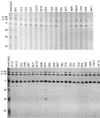Human Stx2-specific monoclonal antibodies prevent systemic complications of Escherichia coli O157:H7 infection
- PMID: 11796590
- PMCID: PMC127659
- DOI: 10.1128/IAI.70.2.612-619.2002
Human Stx2-specific monoclonal antibodies prevent systemic complications of Escherichia coli O157:H7 infection
Abstract
Hemolytic-uremic syndrome (HUS) is a serious complication predominantly associated with infection by enterohemorrhagic Escherichia coli (EHEC), such as E. coli O157:H7. EHEC can produce Shiga toxin 1 (Stx1) and/or Shiga toxin 2 (Stx2), both of which are exotoxins comprised of active (A) and binding (B) subunits. In piglets and mice, Stx can induce fatal neurological symptoms. Polyclonal Stx2 antiserum can prevent these effects in piglets infected with the Stx2-producing E. coli O157:H7 strain 86-24. Human monoclonal antibodies (HuMAbs) against Stx2 were developed as potential passive immunotherapeutic reagents for the prevention and/or treatment of HUS. Transgenic mice bearing unrearranged human immunoglobulin (Ig) heavy and kappa light chain loci (HuMAb___Mouse) were immunized with formalin-inactivated Stx2. Thirty-seven stable hybridomas secreting Stx2-specific HuMAbs were isolated: 33 IgG1kappa A-subunit-specific and 3 IgG1kappa and 1 IgG3kappa B-subunit-specific antibodies. Six IgG1kappa A-subunit-specific (1G3, 2F10, 3E9, 4H9, 5A4, and 5C12) and two IgG1kappa B-subunit-specific (5H8 and 6G3) HuMAbs demonstrated neutralization of > 95% activity of 1 ng of Stx2 in the presence of 0.04 microg of HuMAb in vitro and significant prolongation of survival of mice given 50 microg of HuMAb intraperitoneally (i.p.) and 25 ng of Stx2 intravenously. When administered i.p. to gnotobiotic piglets 6 or 12 h after infection with E. coli O157:H7 strain 86-24, HuMAbs 2F10, 3E9, 5H8, and 5C12 prolonged survival and prevented development of fatal neurological signs and cerebral lesions. The Stx2-neutralizing ability of these HuMAbs could potentially be used clinically to passively protect against HUS development in individuals infected with Stx-producing bacteria, including E. coli O157:H7.
Figures

Similar articles
-
Immunization of pregnant cows with Shiga toxin-2 induces high levels of specific colostral antibodies and lactoferrin able to neutralize E. coli O157:H7 pathogenicity.Vaccine. 2018 Mar 20;36(13):1728-1735. doi: 10.1016/j.vaccine.2018.02.060. Epub 2018 Feb 23. Vaccine. 2018. PMID: 29483033
-
Efficacy of Urtoxazumab (TMA-15 Humanized Monoclonal Antibody Specific for Shiga Toxin 2) Against Post-Diarrheal Neurological Sequelae Caused by Escherichia coli O157:H7 Infection in the Neonatal Gnotobiotic Piglet Model.Toxins (Basel). 2017 Jan 26;9(2):49. doi: 10.3390/toxins9020049. Toxins (Basel). 2017. PMID: 28134751 Free PMC article.
-
Shiga toxin-producing Escherichia coli infection and antibodies against Stx2 and Stx1 in household contacts of children with enteropathic hemolytic-uremic syndrome.J Clin Microbiol. 2002 May;40(5):1773-82. doi: 10.1128/JCM.40.5.1773-1782.2002. J Clin Microbiol. 2002. PMID: 11980959 Free PMC article.
-
Antibody therapy in the management of shiga toxin-induced hemolytic uremic syndrome.Clin Microbiol Rev. 2004 Oct;17(4):926-41, table of contents. doi: 10.1128/CMR.17.4.926-941.2004. Clin Microbiol Rev. 2004. PMID: 15489355 Free PMC article. Review.
-
Do the A subunits contribute to the differences in the toxicity of Shiga toxin 1 and Shiga toxin 2?Toxins (Basel). 2015 Apr 29;7(5):1467-85. doi: 10.3390/toxins7051467. Toxins (Basel). 2015. PMID: 25938272 Free PMC article. Review.
Cited by
-
The molecular mechanism of Shiga toxin Stx2e neutralization by a single-domain antibody targeting the cell receptor-binding domain.J Biol Chem. 2014 Sep 5;289(36):25374-81. doi: 10.1074/jbc.M114.566257. Epub 2014 Jul 22. J Biol Chem. 2014. PMID: 25053417 Free PMC article.
-
Fusion expression and immunogenicity of EHEC EspA-Stx2Al protein: implications for the vaccine development.J Microbiol. 2009 Aug;47(4):498-505. doi: 10.1007/s12275-009-0116-8. Epub 2009 Sep 9. J Microbiol. 2009. PMID: 19763426
-
A nanobody targeting the translocated intimin receptor inhibits the attachment of enterohemorrhagic E. coli to human colonic mucosa.PLoS Pathog. 2019 Aug 29;15(8):e1008031. doi: 10.1371/journal.ppat.1008031. eCollection 2019 Aug. PLoS Pathog. 2019. PMID: 31465434 Free PMC article.
-
The 13C4 monoclonal antibody that neutralizes Shiga toxin Type 1 (Stx1) recognizes three regions on the Stx1 B subunit and prevents Stx1 from binding to its eukaryotic receptor globotriaosylceramide.Infect Immun. 2006 Dec;74(12):6992-8. doi: 10.1128/IAI.01247-06. Epub 2006 Oct 9. Infect Immun. 2006. PMID: 17030576 Free PMC article.
-
Antibody recognition of Shiga toxins (Stxs): computational identification of the epitopes of Stx2 subunit A to the antibodies 11E10 and S2C4.PLoS One. 2014 Feb 5;9(2):e88191. doi: 10.1371/journal.pone.0088191. eCollection 2014. PLoS One. 2014. PMID: 24516609 Free PMC article.
References
-
- Benjamini, E., G. Sunshine, and S. Leskowitz. 1996. Immunology: a short course, 3rd ed., p. 77-92. John Wiley & Sons, Inc., New York, N.Y.
-
- Bitzan, M., M. Klemt, R. Steffens, and D. E. Muller-Wiefel. 1993. Differences in verotoxin neutralizing activity of therapeutic immunoglobulins and sera from healthy controls. Infection 21:140-145. - PubMed
-
- Donohue-Rolfe, A., D. W. Acheson, A. V. Kane, and G. T. Keusch. 1989. Purification of Shiga toxin and Shiga-like toxins I and II by receptor analog affinity chromatography with immobilized P1 glycoprotein and production of cross-reactive monoclonal antibodies. Infect. Immun. 57:3888-3893. - PMC - PubMed
Publication types
MeSH terms
Substances
Grants and funding
LinkOut - more resources
Full Text Sources
Other Literature Sources

